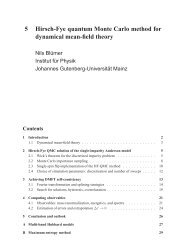Hubbard Model for Asymmetric Ultracold Fermionic ... - KOMET 337
Hubbard Model for Asymmetric Ultracold Fermionic ... - KOMET 337
Hubbard Model for Asymmetric Ultracold Fermionic ... - KOMET 337
Create successful ePaper yourself
Turn your PDF publications into a flip-book with our unique Google optimized e-Paper software.
4.5. CRITICAL TEMPERATURES 430.4∆0.30.20.1-5 -4 -3 -2 -1UFigure 4.7: Superfluid order parameter ∆ as a function of U. For small values of U, the orderparameter becomes exponentially small.The numerical results can now be summarized as follows:- At half filling we are able to show analytically that ∆ > 0 is the correct solution.- Numerically we are not able to detect ∆ <strong>for</strong> small values of U (|U| ≪ t ↑ + t ↓ ), since ∆becomes exponentially small.- Near half filling (n ≈ 0.79) we need U to be greater than a critical value in order to getsuperfluidity.- Superfluid solutions are non-magnetized solutions of the second type near half filling.- Far away from half filling (n ≈ 0.18) we need U to be even greater than in the situationnear half filling.- Superfluid solutions are magnetized far away from half filling.With these calculations we have been able to see the basic effects arising from spin-dependenthopping. It is not surprising that, the further we are away from half filling the more oursystem tends to be magnetized and non-superfluid, since the symmetric pairing is suppressedby magnetization and the non-interacting system is rigorously magnetized.4.5 Critical temperaturesIn this section we present the behavior of the critical temperature of the superfluid orderparameter ∆ in the superfluid phase and the critical temperature of the order parameter s ofthe CDW phase at half filling. We first show that at 0 ≤ T < T C,∆/s the superfluid and theCDW solution always have a lower free energy then the non-symmetry-broken one. Then wepresent the self-consistency equation at T = T C,∆/s in order to calculate T C,∆/s numerically.4.5.1 Superfluidity in non-magnetized solutionsWe now show that non-magnetized solutions of first type (see section 2.4.3) are always superfluidbelow a certain critical temperature T C,∆/s . This will be demonstrated <strong>for</strong> the modelwith spin-dependent hopping, half filling and B = 0. The proof at spin-independent hoppingand B = 0 is analogous <strong>for</strong> the superfluid case. (The filling is unimportant here, since awayfrom half filling we do not expect magnetization to occur at B = 0.) In order to show this













